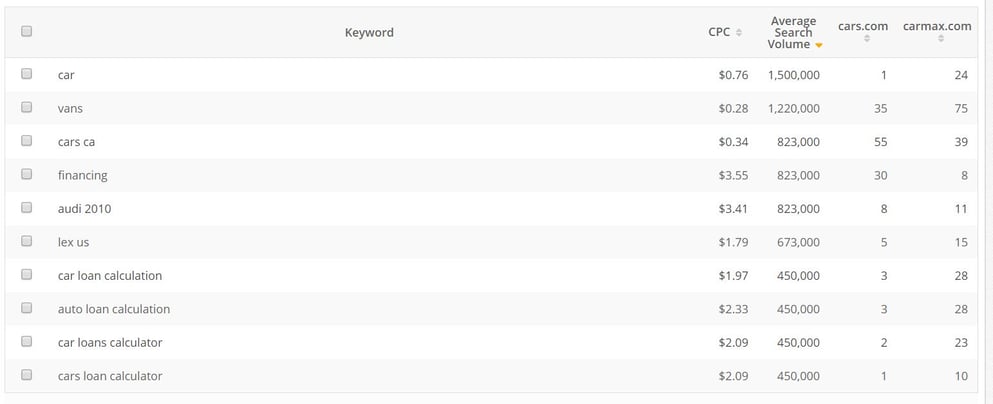At almost every client meeting, someone in the room will approach me and whisper a question about competitive intelligence, as if it's a sneaky or dishonest tactic.
But analyzing competitor keywords is a completely legitimate way to gain insights about your market, create a solid content strategy, uncover your target audience, and engage potential customers.
In fact, I believe competitive keyword research is by far the most effective way to increase organic visibility.
In this post, I'll walk you through an amazing method to improve competitive keyword research - identifying content gaps.
Table of Contents:
- What is a Content Gap?
- What Is a Content Gap Analysis?
- The Benefits of a Content Gap Analysis for SEO
What is a Content Gap?
A content gap is a portion of the search landscape for which your competitors rank but you don't.
These gaps often surface during a thorough analysis of your competitors' content and your target audience's needs, revealing topics or questions that haven't been adequately addressed on your site.
Identifying these gaps is crucial for developing a more comprehensive content strategy that resonates with your audience's interests and search intent.
What Is a Content Gap Analysis?
A content gap analysis is the strategic process of evaluating the difference (or "the gap") between keywords for which you and your competitors rank in the search results.
This analysis involves comparing your content with competitors' and assessing search query data to uncover topics, keywords, and questions that are currently underrepresented.
Note: You can also conduct an SEO content gaps analysis to evaluate specific content assets and uncover how to improve your pages. In this guide, however, we’re focusing on the keyword research aspect of such analysis.
As you'll see, this analysis allows you to increase the quality and quantity of your keyword lists, uncover new opportunities, and improve your overall SEO strategy.
What Happens if You Don't Close Content Gaps?
Every keyword a competitor ranks for and you don’t is a lost opportunity for your organization to receive more traffic and conversions. To put it in business terms, every one of those keywords means lost sales and revenue.
Unfortunately, I see companies suffering from the content gap all the time. Most of them don’t even realize it. Others, fail to see the benefits of analyzing competitive strategies to uncover it.
So what happens if you don't close the content gap?
Look at the screenshot below. It shows the difference in keywords between two domains.
Here, you can see that CarMax misses out on over 500,000 potential keywords against its competitor! This reveals a huge opportunity for carmax.com to increase its search visibility against one of its competitors.

(A gap analysis between two domains.)
What’s more, the report reveals that the content gap translates to 114,834,902 lost traffic potential.
But, CarMax misses out on more than just traffic by not using competitive insights to uncover that content gap. Let's dive into some of the main advantages of identifying content gaps.
The Benefits of a Content Gap Analysis for SEO
Some of the main benefits of analyzing competitive keywords include:
- Better aligning your strategies with the buyer’s journey. After all, a competitor might have uncovered additional phrases or topics customers use when researching their products or services. While you may eventually discover those phrases on your own, competitive research will speed up the process immensely.
- Increasing the relevancy of your website. That is, if you act on your findings.
- A better understanding of how your competitors gained the search visibility they have. Such insight will provide you with a much stronger foundation to plan your next move.
- Uncovering new topics and keywords. These insights will help strengthen your topic clusters and overall site authority.
This last point is particularly impactful as researching content gaps helps improve keyword research significantly.
One of the goals of keyword analysis - besides uncovering new search phrases to target - is finding ways to position your brand along the buyer’s journey.
We already know that the majority of customers conduct most of their research using a search engine. Unfortunately, many marketers fail to uncover all the topics and phrases customers look for throughout their search journey.
Analyzing competitor phrases is the quickest way to discover relevant search queries you haven’t yet encountered in your research.
The best news? Doing so isn’t even difficult.
Let me walk you through the process.
How to Perform a Content Gap Analysis
For this demonstration, I’ll use the seoClarity platform to illustrate the process.
In the Content Gaps portion of the platform, you're able to specify your domain or URL, and any other domains whose keywords you’d like to compare against (you can use a maximum of 5 domains, including yours).

(You can analyze the content gap by device and location too, giving you access to highly targeted data.)
seoClarity's proprietary analysis methodology, Wisdom of the Crowds, will look for ranking phrases you and your competitors have in common as well as those only a specific domain ranks for. You can also add your domain to see where you don't rank and where your competitors do to get a complete picture of your industry against your site.
For this example, we will take a look at the associated metrics for Carmax.com and Cars.com:
Between those two domains, there are over 700,000 lost keyword opportunities and over 100M lost visits.
Incredible, right? Putting a value to a keyword or considering your average conversion could quickly reveal what sort of revenue you might be missing due to a content gap. While this is a very basic calculation that doesn’t take into consideration many factors like keyword intent or type, it’s enough to illustrate the lost opportunity of not ranking for those keywords.

(There is countless opportunity found from this analysis!)
From then on, you can scroll down to review keywords per domain. Note that seoClarity also reports on rankings per keyword, giving you additional data points to base your next actions on.

In addition, the platform also reports on the traffic and keyword opportunities for you. It lets you know what gains you could expect if you start closing the content gap.
You can also filter out any brand keyword terms, rank position, and many other factors. This helps to narrow down the opportunities in a manageable way and begin to track your progress.
Content Gap Workflow: How to Close Content Gaps
Identifying the content gap is easy. But figuring out where to start closing it (especially when dealing with tens of thousands of potential keywords) poses quite a challenge.
After all, you can’t just start at the top of the list and work your way down.
To help you prioritize, I've listed some of the most effective strategies to start closing content gaps and quickly see positive ROI.
Strategy #1: Start With Keywords Relevant to Your Existing Assets
The biggest challenge when trying to rank for all those additional keywords is producing quality content. But you likely already have some assets that could help you rank for these new phrases.
Rather than churning out a ton of new content, start by identifying keywords that relate to pages or other content assets you already have. Then, update those existing assets to make them more relevant for the additional keywords.
You should also look for opportunities to repurpose existing assets into content that could effectively target the gaps.
For example, if your organization produced eBooks or white papers that relate to some of the phrases you’ve identified in the content gap analysis, you could use sections from those publications as blog posts or other landing pages and optimize them for content gap phrases.
Strategy #2: Target Commercial Keywords First
The premise behind this strategy is simple: commercial keywords provide the highest opportunity for achieving ROI. So focusing on them first helps you quickly deliver results for your organization.
To begin, assess your content gap keywords to identify phrases that correspond with buying intent. Many of these keywords will likely relate to various content assets you already have — product pages, sales pages, etc. As such, you’ll just need to update the content on those pages to target them.
You could also begin building dedicated landing pages. While this will take time and resources, the potential revenue they might generate could make the project well worth it.
Strategy #3: Target Quick Gains
In this case, quick gains refer to keywords you are positive you could quickly outrank the competition for.
These could be keywords you already have existing high-quality content assets for or phrases where you can quickly exercise your domain authority to overtake the SERPs.
Another prime example is phrases connected to areas where you already possess great expertise. As such, it would be easy for you to generate highly valuable content without completing much additional research. The key to this particular strategy is to identify phrases you could rank for quickly to show the ROI of closing the content gap most quickly.
Strategy #4: Conduct a Content Audit
A content audit reveals the existing content on your site, helping you identify redundant content as well as opportunities to refresh content to further drive visibility against your competitors.
Conducting a content audit also is a great way to ensure that you've targeted the right keywords with the right user intent.
Perhaps most importantly, a content audit helps evaluate your content performance and reveals poor-performing content that might need to be removed from your site.
Key Takeaways
Out of all the various ways to increase search visibility, nothing beats identifying keywords that your competitors rank for and you don't.
With that insight, you just need to create content that helps position your site for those phrases and you’re on the way to boosting traffic and organic conversions.
Gain Competitive Advantage with the Most Powerful, Enterprise-Level SEO Platform.
Book a Demo Now.
Editor's Note: This post was originally published in June 2017 and has been updated for accuracy and comprehensiveness.






1 Comment
Click here to read/write comments